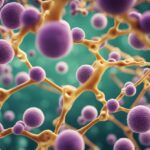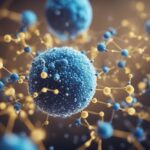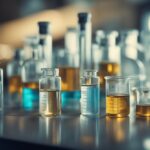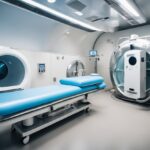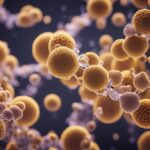Cellular rejuvenation has been a topic of interest in the field of anti-aging for many years. As we age, our cells undergo various changes that contribute to the aging process. Cellular rejuvenation aims to reverse or slow down these changes, ultimately leading to a more youthful and healthy appearance. In recent years, there has been a growing interest in this area of research, with many promising developments and interventions emerging.

Fundamentals of Cellular Aging Aging is a complex process that involves various biological mechanisms, including cellular changes. As we age, our cells become less efficient at repairing themselves, leading to a buildup of damage and dysfunction. This can result in a range of age-related diseases and conditions, such as wrinkles, age spots, and loss of muscle mass. Cellular rejuvenation aims to address these changes by promoting cellular repair and regeneration.
Key Takeaways
- Cellular rejuvenation aims to reverse or slow down the cellular changes that contribute to the aging process.
- Aging involves various biological mechanisms, including cellular changes that result in a buildup of damage and dysfunction.
- Cellular rejuvenation promotes cellular repair and regeneration to address these changes and improve overall health and appearance.
Fundamentals of Cellular Aging
Cellular Senescence
Cellular senescence refers to the irreversible growth arrest of cells, which occurs due to various stressors such as DNA damage, telomere shortening, and oxidative stress. Senescent cells accumulate with age and contribute to the development of age-related diseases. These cells also secrete pro-inflammatory cytokines and other molecules that can cause damage to surrounding tissues.
Telomere Shortening
Telomeres are repetitive DNA sequences located at the ends of chromosomes that protect them from degradation. During each cell division, telomeres become shorter, eventually leading to cellular senescence or apoptosis. Telomere shortening is a hallmark of aging and is influenced by various factors such as oxidative stress, inflammation, and lifestyle factors such as diet and exercise.
Stem Cell Exhaustion
Stem cells are responsible for tissue repair and regeneration. With age, the number and function of stem cells decline, leading to impaired tissue repair and regeneration. This decline in stem cell function is due to various factors such as oxidative stress, inflammation, and changes in the microenvironment of stem cells.
Overall, cellular aging is a complex process influenced by various factors. Understanding the fundamentals of cellular aging can help in the development of interventions for anti-aging and age-related diseases.
Mechanisms of Cellular Rejuvenation
Cellular rejuvenation is a promising approach to anti-aging that focuses on restoring the function of aging cells. There are several mechanisms of cellular rejuvenation that have been investigated, including telomerase activation, senolytic therapies, and stem cell therapy.
Telomerase Activation
Telomeres are repetitive DNA sequences located at the ends of chromosomes that protect them from damage. Telomeres shorten with each cell division, and when they become too short, cells enter a state of senescence and stop dividing. Telomerase is an enzyme that can add length to telomeres, and its activation has been shown to reverse cellular aging in some studies.
Several approaches have been developed to activate telomerase, including small molecule drugs and gene therapy. However, the safety and efficacy of these approaches are still being investigated, and there are concerns about the potential risks of telomerase activation, such as cancer.
Senolytic Therapies
Senescent cells are cells that have stopped dividing and entered a state of permanent growth arrest. These cells accumulate with age and contribute to age-related diseases by secreting harmful molecules and disrupting tissue function. Senolytic therapies are designed to selectively eliminate senescent cells, thereby rejuvenating tissues and improving healthspan.
Senolytic therapies can be delivered using small molecule drugs or gene therapy. Several senolytic drugs have been developed and are currently being tested in clinical trials. However, the safety and efficacy of these therapies are still being investigated, and there are concerns about the potential side effects of senolytic treatments.
Stem Cell Therapy
Stem cells are cells that have the ability to differentiate into various cell types and regenerate damaged tissues. Stem cell therapy involves the transplantation of stem cells into damaged tissues to promote regeneration and rejuvenation.
Stem cell therapy has shown promise in preclinical studies and early clinical trials for a variety of age-related diseases, such as osteoarthritis and Alzheimer’s disease. However, there are concerns about the safety and efficacy of stem cell therapy, such as the risk of immune rejection and tumor formation.
In conclusion, cellular rejuvenation has the potential to revolutionize the field of anti-aging by restoring the function of aging cells. However, further research is needed to fully understand the mechanisms of cellular rejuvenation and to develop safe and effective therapies for human use.
Lifestyle Factors Influencing Cellular Health

Maintaining healthy cells is essential for anti-aging and cellular rejuvenation. While genetics play a role, lifestyle factors such as nutrition, exercise, and sleep also influence cellular health.
Nutrition and Diet
A balanced diet rich in nutrients is essential for cellular health. Antioxidants, vitamins, and minerals protect cells from damage and support their function. A diet high in processed foods, sugar, and unhealthy fats, on the other hand, can lead to inflammation and oxidative stress, which can damage cells and accelerate aging.
To support cellular health, a diet should include plenty of fruits, vegetables, whole grains, lean protein, and healthy fats. Omega-3 fatty acids, found in fatty fish, nuts, and seeds, have been shown to reduce inflammation and support cellular health.
Exercise and Physical Activity
Regular exercise and physical activity are also essential for cellular health. Exercise has been shown to improve mitochondrial function, which is important for energy production and cellular repair. It also reduces inflammation and oxidative stress, which can damage cells and accelerate aging.
To support cellular health, individuals should aim for at least 150 minutes of moderate-intensity exercise or 75 minutes of vigorous-intensity exercise per week. This can include activities such as walking, jogging, cycling, or strength training.
Sleep and Circadian Rhythms
Sleep is crucial for cellular repair and rejuvenation. During sleep, the body repairs damaged cells and produces new ones. Chronic sleep deprivation can lead to inflammation, oxidative stress, and impaired immune function, which can damage cells and accelerate aging.
To support cellular health, individuals should aim for 7-9 hours of quality sleep per night. They should also maintain a regular sleep schedule and practice good sleep hygiene, such as avoiding electronics before bed and creating a relaxing sleep environment.
By prioritizing nutrition, exercise, and sleep, individuals can support cellular health and promote anti-aging and cellular rejuvenation.
Pharmacological Interventions
Antioxidants and Supplements
Antioxidants and supplements have been studied for their potential to promote cellular rejuvenation and slow down the aging process. Antioxidants such as vitamin C, vitamin E, and coenzyme Q10 have been found to reduce oxidative stress, which is a major contributor to aging. These antioxidants work by neutralizing free radicals, which can damage cells and accelerate aging.
Supplements such as resveratrol, curcumin, and omega-3 fatty acids have also been studied for their anti-aging effects. Resveratrol, found in red wine and grapes, has been found to activate sirtuins, which are enzymes that play a role in cellular rejuvenation. Curcumin, found in turmeric, has been found to have anti-inflammatory and antioxidant properties. Omega-3 fatty acids, found in fish oil, have been found to reduce inflammation and promote cellular health.
Hormetic Agents
Hormetic agents are compounds that induce a mild stress response in cells, which can lead to cellular rejuvenation and anti-aging effects. Examples of hormetic agents include exercise, fasting, and heat stress. Exercise has been found to increase the production of growth factors and promote cellular repair. Fasting has been found to activate cellular stress pathways and promote cellular rejuvenation. Heat stress, such as sauna use, has been found to induce heat shock proteins, which can protect cells from damage.
Geroprotectors
Geroprotectors are compounds that have been found to extend lifespan and promote healthy aging in animal models. Examples of geroprotectors include rapamycin, metformin, and senolytics. Rapamycin has been found to extend lifespan in mice and delay age-related diseases. Metformin, a diabetes medication, has been found to extend lifespan in animals and reduce age-related diseases. Senolytics, compounds that target senescent cells, have been found to improve healthspan and reduce age-related diseases in animals.
Overall, pharmacological interventions have shown promise in promoting cellular rejuvenation and slowing down the aging process. However, more research is needed to fully understand their effects and potential risks. It is important to consult with a healthcare professional before starting any new supplement or medication.
Genetic and Epigenetic Factors

Gene Therapy
Gene therapy is an emerging field that has the potential to revolutionize the way we approach anti-aging. It involves introducing new, healthy genes into cells to replace or supplement faulty ones. This approach has shown promise in treating a variety of age-related diseases, such as Alzheimer’s, Parkinson’s, and heart disease.
One of the most exciting applications of gene therapy for anti-aging is the potential to activate telomerase, an enzyme that lengthens telomeres, the protective caps on the ends of chromosomes. Telomeres naturally shorten as we age, and this shortening has been linked to many age-related diseases. By activating telomerase, scientists hope to slow down or even reverse the aging process.
Epigenetic Reprogramming
Epigenetics is the study of changes in gene expression that are not caused by changes in the underlying DNA sequence. These changes can be influenced by a variety of factors, including diet, exercise, and stress. Epigenetic modifications can accumulate over time and contribute to the aging process.
Epigenetic reprogramming involves resetting the epigenetic markers in cells to a more youthful state. This can be achieved through a variety of techniques, such as dietary interventions, exercise, and certain drugs. By resetting the epigenetic markers, scientists hope to reverse some of the age-related changes in gene expression and slow down the aging process.
In conclusion, genetic and epigenetic factors play a significant role in the aging process. Gene therapy and epigenetic reprogramming are two promising approaches that have the potential to revolutionize the way we approach anti-aging. While these techniques are still in the early stages of development, they hold great promise for the future of anti-aging research.
Emerging Technologies in Anti-Aging
Nanotechnology
Nanotechnology has emerged as a promising field in anti-aging research. It involves the use of nanoscale materials and devices to target specific cells and tissues in the body. Nanoparticles can be designed to deliver drugs or nutrients directly to cells, bypassing the digestive system and improving their absorption. Researchers are also exploring the use of nanotechnology to develop new diagnostic tools for early detection of age-related diseases.
AI-Driven Drug Discovery
Artificial intelligence (AI) is revolutionizing the drug discovery process by enabling researchers to analyze vast amounts of data and identify potential drug candidates more quickly and accurately. Machine learning algorithms can predict the efficacy and safety of new drugs, reducing the need for costly and time-consuming clinical trials. AI is also being used to develop personalized treatments based on an individual’s genetic profile and medical history.
3D Bioprinting of Tissues
3D bioprinting is a cutting-edge technology that allows researchers to create living tissues and organs using a printer-like device. This technology has the potential to revolutionize the field of regenerative medicine, enabling the production of replacement tissues and organs for patients with age-related diseases. Researchers are also exploring the use of 3D bioprinting to create skin grafts, cartilage, and bone tissue for cosmetic and reconstructive surgery.
In conclusion, emerging technologies such as nanotechnology, AI-driven drug discovery, and 3D bioprinting are offering new possibilities for anti-aging research. While these technologies are still in their early stages, they hold great promise for improving human health and extending lifespan.
Ethical and Social Considerations
Access to Treatments
As cellular rejuvenation therapies become more advanced, there is a concern that they may only be available to those who can afford them. This could lead to a widening gap between the rich and poor, with only the wealthy having access to life-extending treatments. It is important for society to ensure that these treatments are accessible to all, regardless of their financial status.
Longevity and Society
The prospect of significantly extending human lifespan raises questions about how society will adapt to an aging population. There may be economic and social challenges to consider, such as a strain on healthcare systems and retirement funds. However, there may also be benefits, such as a more experienced and knowledgeable workforce.
Ethical Implications of Life Extension
Extending human lifespan also raises ethical questions, such as whether it is morally justifiable to prolong life indefinitely. Some argue that it is natural for humans to age and die, and that extending life goes against the natural order of things. Others argue that life extension is a fundamental human right and that it is ethical to pursue it.
It is important for society to have open and honest discussions about the ethical implications of life extension and to ensure that any advances in cellular rejuvenation are made with careful consideration of the potential consequences.
Future Directions in Anti-Aging Research
Clinical Trials
As the field of anti-aging research continues to evolve, there is a growing need for more comprehensive clinical trials to test the efficacy and safety of various rejuvenation therapies. These trials should be designed to include larger sample sizes, longer follow-up periods, and more rigorous outcome measures to ensure that the results are reliable and reproducible.
To facilitate this, there is a need for more funding and resources to support clinical research in this area. Additionally, there is a need for more collaboration between researchers, clinicians, and industry partners to ensure that the most promising therapies are identified and brought to market as quickly and safely as possible.
Interdisciplinary Approaches
Another important direction for anti-aging research is the development of interdisciplinary approaches that integrate knowledge and expertise from multiple fields. For example, researchers in the fields of genetics, biochemistry, and neuroscience can work together to develop a more comprehensive understanding of the underlying mechanisms of aging and identify new targets for intervention.
In addition, researchers can draw on the latest advances in technology, such as artificial intelligence and machine learning, to analyze large datasets and identify new patterns and trends that may be relevant to aging and rejuvenation.
Global Collaboration Initiatives
Finally, there is a need for more global collaboration initiatives to bring together researchers from around the world to share knowledge, resources, and expertise. This can help to accelerate the pace of research and ensure that the most promising therapies are identified and developed as quickly as possible.
One example of this type of collaboration is the Global Consortium for Rejuvenation and Longevity, which brings together researchers from around the world to share data and collaborate on research projects related to aging and rejuvenation.
Overall, the future of anti-aging research is bright, and there is a growing sense of optimism that new therapies and interventions will be developed in the coming years that can help to extend healthy lifespan and improve quality of life for people around the world.
Frequently Asked Questions
What are the latest advancements in cell rejuvenation for anti-aging?
There have been many recent advancements in the field of cell rejuvenation for anti-aging. Some of the most promising research involves the use of stem cells, which have the ability to differentiate into various types of cells and regenerate damaged tissue. Additionally, scientists are exploring the use of chemical reprogramming to reverse cellular aging.
How does stem cell rejuvenation therapy work to combat aging?
Stem cell rejuvenation therapy involves the use of stem cells to regenerate damaged tissue and promote overall cellular health. Stem cells can differentiate into various types of cells, such as skin cells or muscle cells, and can replace damaged or aging cells in the body. This can lead to improved overall health and a reduction in the visible signs of aging.
What are the potential risks and benefits of cell rejuvenation supplements?
Cell rejuvenation supplements are designed to promote cellular health and combat the effects of aging. While there are potential benefits to using these supplements, such as improved skin health and increased energy levels, there are also potential risks. Some supplements may interact with other medications, or may not be effective for all individuals. Additionally, there is limited research on the long-term effects of these supplements.
Can chemically induced reprogramming reverse cellular aging, and how is it applied?
Chemically induced reprogramming involves the use of chemicals to reverse the aging process in cells. This process has shown promise in laboratory studies, but has not yet been extensively tested in humans. The application of this process involves exposing cells to specific chemicals, which can reprogram them to a more youthful state.
What is the average cost of stem cell rejuvenation treatments?
The cost of stem cell rejuvenation treatments can vary widely depending on the type of treatment and the location where it is performed. Generally, these treatments can be quite expensive, with costs ranging from several thousand to tens of thousands of dollars.
How does regenerative therapy contribute to anti-aging processes?
Regenerative therapy involves the use of stem cells or other regenerative cells to promote healing and regeneration in the body. This can lead to improved overall health and a reduction in the visible signs of aging. Regenerative therapy is still a relatively new field, but has shown promise in treating a variety of conditions associated with aging.

